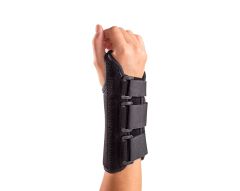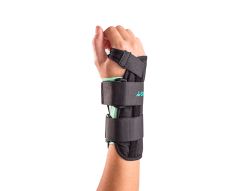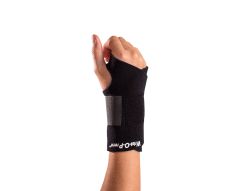Wrist Sprain
Though some may think of the wrist as a single bone, it actually consists of 15 bones and many ligaments, which are strong bands of tissue that connect them to one another. A wrist sprain occurs when any of these ligaments is stretched too far or torn, and it is a fairly common injury for athletes of a number of different sports.
What Causes a Wrist Sprain?
The wrist is made up of eight small bones within the base of the hand, which are attached to the five lower bones in our hand (metacarpals) and the two bones of the forearm (radius and ulna). These 15 bones are connected and surrounded by numerous ligaments and cartilage, which allow for movement and cushion the bones from rubbing against each other. Any of the ligaments in the wrist can be damaged by a movement—such as an extreme twist, bend or direct impact—that forces the wrist into a position beyond its normal range of motion.
The excessive force that leads to a wrist sprain can come about in many different ways, but in most cases a fall is responsible. Any time we experience a fall, there is a natural instinct to outstretch our hand(s) to soften the impact, but the weight of our body on the wrist is usually more than it can withstand. This is why athletes of various sports in which falls are common often experience wrist sprains, including football, cycling, skiing, snowboarding, basketball, diving and gymnastics. Wrist sprains may also occur in weightlifting or boxing, especially in athletes with poor lifting or punching techniques. In rare cases, a sprained wrist may develop as an overuse injury from activities that put too much strain on the wrist over a period of time.
What are the Symptoms?
Wrist sprains can range from mild to severe, and as with all other sprains, they can be graded as follows:
- Grade 1 (Mild): ligaments are stretched but not torn
- Grade 2 (Moderate): ligaments are partially torn
- Grade 3 (Severe): ligaments are completely torn; surgery may be necessary
Symptoms will vary depending on the grade and location of the sprain, but most patients will experience pain immediately after the incident that caused the injury. In more mild sprains, the wrist may also be slightly swollen and tender, and there will usually be some pain when moving the wrist. For more severe sprains, there may be enough swelling to change the shape of your wrist, as well as some bruising, and more significant pain will occur with any wrist movement. Not being able to move the wrist can also result in loss of strength and stability, making the wrist practically useless prior to treatment in some cases.
What is the Treatment?
Unless the injury is extremely minor, it’s essential to see a medical professional as soon as possible after the incident to prevent any long-term complications. The doctor will perform a full-scale evaluation that includes an examination of the wrist and a series of tests and questions regarding the injury that will help to establish a diagnosis. If the injury is severe, the doctor may order additional tests like an X-ray or MRI to rule out a broken wrist or to determine how severe the injury is.
Fortunately, the majority of wrist sprains are easy to treat, and most patients with mild-to-moderate sprains can recover and return to activities within about 2-6 weeks. The first line of treatment should be conservative (non-surgical), and will usually consist of the RICE protocol and physical therapy:
RICE
- Rest: avoid any activities that can aggravate the wrist for at least 48 hours
- Ice: apply an ice pack or cold compress to the wrist for 20-30 minutes every 3-4 hours for the first 2-3 days
- Compression: use a compression bandage or support to reduce swelling
- Elevation: raise the wrist above heart level, which will also reduce swelling and encourage excess fluids to drain away
Physical Therapy
The goals of physical therapy are to speed up the healing process, ensure an optimal recovery and reduce the chance of another wrist sprain in the future. Rehabilitation will vary depending on the individual and the injury, but will usually consist of some of the following:
Wrist taping and/or Bracing
Keeping the wrist from moving (immobilization) is often needed for more severe wrist sprains, and may be recommended for 1-2 weeks to let the ligaments heal; the Aircast A2 Wrist Brace and Quick Fit Wrist are for this purpose and may be prescribed. For a 2nd degree sprain or moderate injury, the Elastic Wrist Splint or DonJoy ComfortForm Wrist Support is ideal. For a 1st degree wrist sprain or mild injury, the Universal Wrist O Prene or Boomerang Wrist will provide mild compression and support.
Passive Modalities
Ice, heat and soft-tissue massage may be performed by the therapist to address symptoms.
Stretching Exercises
Once symptoms have subsided, active exercises are added; stretching exercises will help to increase flexibility that may have been lost.
Strengthening Exercises
Resistance bands and therapeutic rubber balls are helpful to build strength back up in the wrist and surrounding areas.
Patient Education
Therapists will work with patients to help them modify dangerous activities and gradually return to sports or activities based on their progress.
Surgery
Though it is rare, surgery is sometimes needed following a complete rupture of a ligament with significant disability or if there is a fracture. The surgical procedure usually involves reattaching the ligament to the bone, which is followed by a wrist splint or cast for about six weeks and a course of physical therapy.
How to Prevent a Sprained Wrist?
Wrist sprains are difficult to prevent, since they are usually caused by an unexpected accident, but there are some steps you can take that may reduce the risk for injury:
- Always use caution when walking or running on wet or slippery surfaces
- Try to resist the urge to put out your hand(s) during a fall
- Perform wrist-strengthening exercises, which can be prescribed by a physical therapist
- Wear a protective brace or support with tape, which will prevent the wrist from bending too far backward; this especially applies to those who have already injured their wrist and to athletes in sports like snowboarding, skiing, skateboarding and cycling







